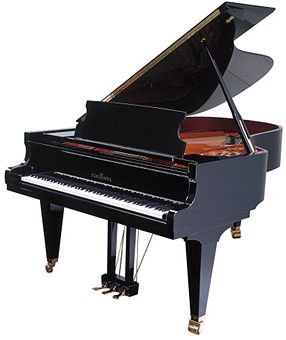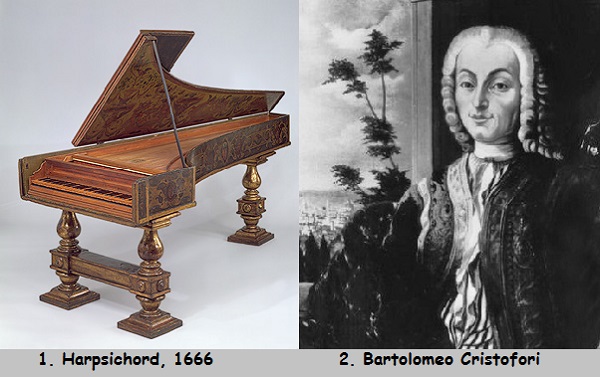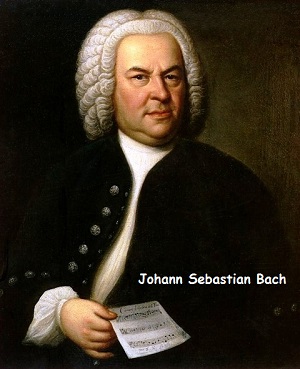Let’s take a look at the history of the piano.
When talking about piano history, mention must be made of the early instruments that paved its way.
The first historical mention of instruments is in Genesis 4:21. The King James Version reads as follows: “And his brother’s name was Jubal: he was the father of all such as handle the harp and organ”. The first instrument in history to have a keyboard was the Hydraulis, the precursor of the modern organ. It was built in Greece about 220 B.C. By the Second Century A.D. the organ was commonly used at important festivities in Greece and the Roman Empire.
The earliest keyboards were played with the hands, wrists, fists, knees, or feet. Up to the 13th Century the scales were diatonic (as in GABCDEF) rather than the twelve tone chromatic scale we use today.
The piano is founded on earlier technological innovations. The 14th and 15th Centuries saw the development of different kinds of keyboard stringed instruments. Some came with hammers, including the chekker, dulce melos, and clavichord. Some were plucked instruments, including the virginal, spinet and harpsichord.
In this discussion of the history of the piano, let’s now talk about its inventor. Who invented the piano? The modern piano was invented by Bartolomeo Cristofori (1655–1731) of Padua. He was an expert harpsichord maker, employed by Ferdinando de’ Medici, Grand Prince of Tuscany, as the Keeper of the Instruments. The first piano he built was about the year 1700 or 1698. Historians are not in total agreement as to the exact date. The keyboard looked different to today’s piano keyboard layout; the natural keys were black while the accidentals were white. It was Sebastian LeBlanc who suggested that the black and white keys be switched. The three Cristofori pianos that survive today date from the 1720s.

History of the piano – the harpsichord and clavichord
At the time of Bartolomeo Cristofori’s invention of the piano, the most popular keyboard instruments were the harpsichord and the clavichord. Both of these instruments looked like the piano that exists today. The major difference between them and a modern day piano is the way their sound was produced. In a clavichord the strings are struck by tangents, while in a harpsichord they are plucked by quills.
A major drawback of the harpsichord was the fact that the dynamics (loudness or softness) of each note couldn’t be controlled. This meant that composers couldn’t evoke emotion in their music as needed. The clavichord aimed to improve on this shortcoming. While it still plucked at strings, it allowed the strings to continue vibrating as long as the key was depressed. As a result players had more control over the volume of their instrument. The technically more advanced clavichord became very popular but it still had its weaknesses. Although it allowed artists to be more expressive, the tone of the harpsichord was too delicate. It was not suited for large hall performances and would often be drowned by other instruments.
The piano was likely formed as an attempt to combine the loudness of the harpsichord with the control of the clavichord.
Cristofori was able to solve the fundamental mechanical problem of piano design: the hammer must strike the key but not remain in contact with it. That was the problem with the clavichord: the tangent remained in contact with the clavichord string, thus dampening the sound. Additionally, it was imperative that the hammer return to its rest position without bouncing violently, and that the instrument allow one to repeat a note rapidly. Thanks to the work of Cristofori, this was now possible. Many different approaches to piano actions followed, all modeled after Cristofori’s piano action. Although Cristofori’s early instruments came with thin strings and were much quieter than the modern piano, they were significantly louder and had more sustaining power than the clavichord.

Cristofori’s new instrument was known as the pianoforte because it allowed players to produce notes at different dynamic levels by controlling the inertia with which the hammers hit the strings. The original Italian name for the instrument is clavicembalo (or gravicembalo) col piano e forte (literally harpsichord capable of playing at the normal level, and more strongly).
Many years after the first version of the piano was created it was still called a harpsichord. This has made it difficult to know this specific aspect of the history of the piano, whether the great composers of the age such as Scarlatti or Vivaldi knew of its existence. The word pianoforte, shortened later to piano, appeared only in 1732.
Video – Brief History of the Piano
Cristofori’s piano was largely unknown until 1711 when an Italian writer, Scipione Maffei wrote about it. His article was a very enthusiastic one and included a diagram of the mechanism. Subsequently, many piano builders started their work because of what they read in that article. One example was Gottfried Silbermann, better known as an organ builder. He built pianos that were direct copies of Cristofori’s except for one important addition; he invented the forerunner of the damper pedal we use today. It lifts all dampers from the strings at once.
 When speaking about the history of the piano, mention must be made of Johann Sebastian Bach. When Silbermann first showed Bach one of his early instruments in 1736, he did not like it. According to legend, Bach did not think much of its sound. He was said to have destroyed it with an axe. Bach later saw a new instrument in 1747 and approved it. At the time, he was visiting Frederick the Great of Prussia at his court in Potsdam. He improvised an impressive three-part figure on a theme suggested by the king. The instrument caught the attention of composers across Europe. Its fame extended to the British colonies in America. Having a piano in the home became the height of fashion for high-ranking nobles in these colonies.
When speaking about the history of the piano, mention must be made of Johann Sebastian Bach. When Silbermann first showed Bach one of his early instruments in 1736, he did not like it. According to legend, Bach did not think much of its sound. He was said to have destroyed it with an axe. Bach later saw a new instrument in 1747 and approved it. At the time, he was visiting Frederick the Great of Prussia at his court in Potsdam. He improvised an impressive three-part figure on a theme suggested by the king. The instrument caught the attention of composers across Europe. Its fame extended to the British colonies in America. Having a piano in the home became the height of fashion for high-ranking nobles in these colonies.
The history of the piano – the second half/late eighteenth century
The second half of the eighteenth century was characterized by rapid development of the piano. The instrument was made by a number of manufacturers with a focus on coming up with a more powerful, sustained sound. There were English pianos with a heavier mechanism and louder volume while Austrian pianos had a lighter mechanism and softer timbre. The first pianists began to perform in public on this new generation of pianos produced by Broadwood, Stein, Streicher, Zumpe and Tschudi.
During the late 18th century, piano-making flourished in the Viennese school which included the likes of Johann Andreas Stein and the Viennese makers Nannette Streicher and Anton Walter. Viennese-style pianos featured wood frames, two strings per note, and leather-covered hammers. Some of these pianos came with black natural keys and white accidental keys, the opposite of modern day pianos and keyboards. Wolfgang Amadeus Mozart composed his concertos and sonatas for such instruments. The pianos of the Mozart era had a softer more ethereal tone than today’s pianos or English pianos, and had less sustaining power.
Go here to continue reading about the history of the piano.
Who Invented The Piano and Why… and Where?
Are you learning to play the piano? Click here for my number one recommendation for learning how to play.
Return from History of the Piano (Piano History) to home page.